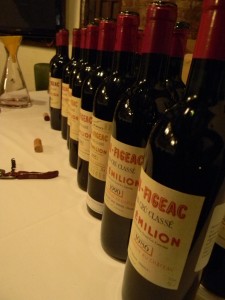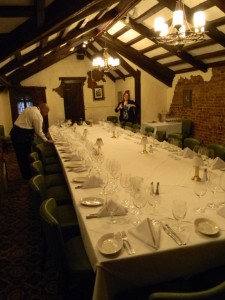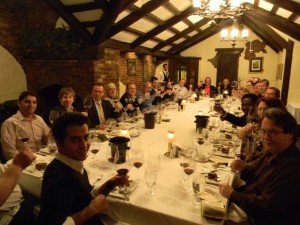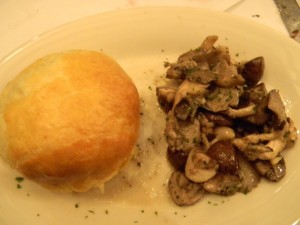11 vintages of Chateau Figeac: freshness over power
January 22, 2012
Château Figeac may be somewhat of a conundrum for neophytes to Bordeaux. Even for some who work in wine. While sampling three white wines at the trendy Vino Volo airport wine bar at Dulles International Airport last week, just before a flight to Frankfurt, Germany, I told the wine salesman there about Figeac being a top notch St Emilion. And he replied that he adores the Merlot from that appellation and recommended a glass of Beau Sejour Becot, also a premier grand cru classé, he stressed.
Yes, but Figeac is made from vines that grow on more gravely terrain and thus includes very little Merlot – it is composed typically of 70% Cabernet Sauvignon and Cabernet Franc… To complicate matters still further, Figeac never followed the drumbeat of the Garagiste Movement on the Right Bank in the early 1990s, sticking to a policy to pick somewhat early, al dente if you will, to retain freshness. And as we reach levels of 15 degrees alcohol and more with many Merlots on the Right Bank these past few years, Figeac to me represents something more authentic and more mineral from Bordeaux, rather than big, bold and sometimes drying aspects from the high alcohol-soaking new oak.
What is perhaps even more surprising is that since the mid 1970s at least, Figeac has been aged in 100% new oak. Even Petrus has not used 100% new oak since 1990. But Jean Claude Berrouet of Petrus explained to me that the high degrees of alcohol in Merlot are not well suited to so much new oak.
Cabernets, on the other hand, can be. And for Figeac owner Eric d’Aramon, the time spent in new oak varies according to the vintage character. For example, the 1997 harvest only saw 12 months in new oak while the 2009 counted 18 months… D’Aramon, who does not like over fruity and over plump plum flavors – see my video below – explained that the new oak he uses is generally low to mid toast, so the purpose is not to impart oak flavors but to more efficiently age the wine – and new oak tends to be more efficient in that regard, he stressed.
So, combine the fact that this is a St Emilion from a unique terroir with mostly Cabernet that is picked somewhat early, and you can see that it will not win many beauty contests when compared with what many tasters expect from beauty contests: a kaleidoscope of plum, raspberry, strawberry, cherry and whatever other (often bordering on over) ripe berry and high-alcohol Merlot derived sensations.
St Emilion and Figeac? A false sense of peerage? It is not an accident that some people call Figeac the Medoc of St Emilion…
In any case it was with great pleasure to organize a tasting of 11 vintages of Chateau Figeac at Ruth’s Chris Steakhouse in Washington DC with wine educator and sommelier Maria Denton. Many thanks to her and her team for preparing a magnificent five course meal to match the wines.
Just before he was to join scores of other Bordeaux chateau representatives to tour the United States to have their 2009 vintage tasted from bottle – in Los Angeles, Chicago and New York – D’Aramon flew into Washington on 18 January exclusively for this tasting dinner – and he generously donated 10 of the 11 vintages. The Parker numbers have never been to high for Figeac, so he wanted to have this wines tasted by American merchants and sommeliers and bloggers, to see what they thought of his wines.
For the most part, all participants were impressed, as was I.
One of the more controversial bottles was the 2000, and to a lesser extent the 1990. Robert Parker had recently downgraded the 2000 vintage from a mid 90s score to a mid 80s score, professing to have “blown it” in his initial judgment. That was a revealing remark, because D’Aramon does not seek big styled St Emilion wines. But he also admitted to having perhaps gone too far in the other direction in 2000. To avoid having too much richness, he may have picked a bit too early, he told participants, who noted some green in the 2000. In defense of the 2000, which I have tasted on several occasions since 2004, it reminded me last week of how the 1995 was about two years ago. Last week the 1995 showed better, somehow having incorporated its greener aspects. As D’Aramon said, the 2000 represents an older style of Bordeaux, and with time, will probably be fine if not delicious.
The 1990 promised great things but proved a bit underwhelming because it lacked some freshness, and I think we just had bad luck with two of the three bottles. One bottle was fine. Interestingly enough, some participants raved over the third bottle which Maria Denton and I had set aside because we thought it to be the dustiest. And even D’Aramon did not want to include it. Perhaps we misjudged it? Perhaps it was a question of more contact with air (although all bottles had been double decanted three hours before the dinner).
The Wines
I was able to taste before the dinner with sommelier Maria Denton. Wines in bold, I liked particularly; in red and bold even more. When underlined, the very best.
2009. Oak still on the nose and palate, a very opulent wine, somewhat mammoth like at this stage but displaying ripe Medoc like cassis and primary fruit, more black than red. It tastes like a barrel sample and has much weight on the palate, with finely grained tannin, albeit just a bit monolithic now. Long finish. 92-95
2006. Cooler nose. Red rather than black fruit, with a touch of violet aromas that are also offset by a bit of iron, lending a just slightly rustic aspect. But the palate is medium plus in body and packs quite a punch, balancing both richness and verve. Do not touch for a few years… 91+
2005. A lovely nose of ripe cassis and cooler blueberry like fruit, this wine exudes a warmer profile on the palate than the 2006. It also has greater volume and depth, nicely balanced with brisk acidity, with a touch of oak derivation slowly receding. I like the very pure cassis aspect to this wine on the palate, which seems more focused than the 2006 and more nuanced than the 2009, although rather tightly wound for now. Potential for a higher score. 95
2004. A mix of graphite and lightly sweet red fruits, plum and cassis. A very smooth medium-bodied palate, just a touch of vanilla flavored with cedar and brambly red and ripe fruit. An appealingly fresh lingering finish with mint. I can understand why so many people liked the 2004 at the dinner. 93+
2001. Pleasing red cherry, more mineral than mentholated freshness here mingle with a certain olive like flavor on the palate. If I had to choose between 2001 and 2004, I would pick the former because it seems to show a touch more depth, a touch more substance on the mid palate especially. Although the finish is similar, the 2001 adds an extra dimension of toffee-like sweetness. 94
2000. Amazing how this wine has transformed from being a super star in 2005 when I tasted it twice (once in a vertical in Germany in February, once in a blind tasting with most of the other premier grand cru classés) to a bit of a question mark in 2012. Eric d’Aramon admits to having picked perhaps too early to preserve freshness, his greatest concern in general. How will this evolve. Some, like critic John Gilman, sees this as a “positive herbaciousness” while others, notably Robert Parker, say he “blew it” when he graded this highly early on and downgraded the wine more recently. My feeling is that it will develop into a better wine, and taste like some of the more appealing 1970s Bordeaux. But there is not guarantee here… 89 for now.
1999. When I first opened this with sommelier Maria Denton, we both marveled at its floral aspects, but there was a bit of VA that showed itself later à table. Whatever the case may be, it exuded a certain freshness and minerality that pleased my palate. Medium bodied, and perhaps somewhat hollow in the middle, this may have been the weakest of the evening. 88
1998. This had to be one of the two or three best wines of the dinner. It certainly wins as the most sumptuous. Whoever thinks Figeac is thin in the 80s and 90s needs to drink this, or has been drinking too many fruit bombs…. Sorry but that is my subjective opinion. This wine reflects a natural concentration due to a hailstorm, d’Aramon explained. Whatever the cause, the result is magnificent, with focused flavors of red and black fruit, nuanced richness and a fine underlying freshness. A great wine indeed. 95
1995. My how this has improved. When I last tried it with Ben Giliberti in Washington DC two or three years ago, a certain green aspect annoyed me. But that was pretty much gone at this dinner, where I noticed a mélange of stony mineral notes, baked plum and hint of cardamom spice. The tannins were not completely melted, displaying a 1995 “solidity” that one encounters in wines of quality on both sides of the Gironde, indicating yet again that 1995 is a vintage to be reckoned with in Bordeaux. 92
1990. The nose seemed like it needed dusting… but then came a mixture of forest floor, tobacco, light leather and blackberry and plum flavors. The palate was rich, but not as exciting as the 1998. There was a dusty tannin aspect to the palate as well, that was even worse in one bottle. Later however, some tasters drank from that bottle and thought that that dusty aspect had gone. I am not so sure. Even d’Aramon felt that the 1990 was not showing its best from at least two of the three bottles he brought over ex-chateau. 92, but could have been higher.
1986. Here was perhaps my wine of the night, because I just absolutely adored a certain crushed mint leaf flavor on the nose and on the palate, coupled with faded flowers and pencil shavings. Fully tertiary and yet of high intensity and precision chiseled by brisk acidity that kept this wine quite youthful in fact. This is not a wine for people who want evident fruit or low acidity… In an eloquent address to dinner participants, Burgundy lover Maureen Nelson compared Figeac to fine Burgundy, and I think that the 1986 certainly illustrates that comparison. For me, a beautiful wine. 96








[…] attended an 11-vintage vertical dinner of Chateau Figeac. The dinner was hosted and organized by Panos Kakaviatos, and Figeac owner and winemaker Eric d’Aramon flew in for the event. Attendees included […]
Thanks for the post I actually learned something from it. Very good content on this site Always looking forward to new post.
I just added this blog site to my rss reader, great stuff. Cannot get enough!
Nice to be visiting your blog again, it has been months for me, always good writings here.
[…] McIntyre writes about the “11-vintage retrospective of Chateau Figeac” recently organized by Panos Kakaviatos. (In case anyone is wondering, I did attend the dinner — and my notes are coming […]
[…] fan of the Château, grateful for the invitation to such an extravagant evening. Enormous thanks to Panos Kakaviatos for organizing such a spectacular […]
I found your blog using msn. This is a really well written article. I will make sure to bookmark it and come back to read more of 11 vintages of Chateau Figeac: freshness over power; Connections to Wine . Thanks for the post. I’ll definitely come back.